DISCLAIMER: This is an exhaustive breakdown on the HiFiMAN HE-6. If you’re an HE-6 fan, or are in the market for a pair, this could be an interesting read, or a handy piece of info you could come back to. Feel free to skip directly to the “Sound” section, or to the summary points at the end of the article. I must also warn you that the information within concerning the different “versions” is only anecdotal, from playing around with seven pairs and obsessively searching up information. HiFiMAN hasn’t released any official statement concerning the differences, and as Crinacle would say:
“I’m just one guy on the Internet.”

The HiFiMAN HE-6 is easily one of my favorite headphones. In fact, if you told me I had $1000 to spend on a single headphone, that’s what I’d likely go for. It’s an engaging and versatile sound that still impresses me after two years of ownership, with some characteristics that set it apart from other planars on the market.
The flagship was introduced in late 2010 with an MSRP of $1199, as part of the “Planar Renaissance” after the technology took a long hiatus since the 70s/80s “Orthodynamic fever”. Its design was unconventional in a few ways. Dr. Fang Bian boasted the use of an “Almost Nanometer Grade” diaphragm coated with a thin gold trace, a pioneering feature now replicated in the Susvara. The HE-6 also stood out through its brutally low efficiency: HiFiMAN quoted an impedance of 50 ohms with a hungry 83.5 dB/mW – however, as you will see, this varies.

Discontinued in 2015, it has gathered a loyal following among audio circles. In fact, HE-6 “lore” is some of the most unorthodox in headphonedom. One distinction folks obsess on is whether a unit is a “4 screw” or a later “6 screw” model, referring to the number of screws that externally surround the driver opening.
When inquiring with a representative about the HE-6se, I have been told that the drivers differ from the original model. The four to five-year gap between the discontinuation of the HE-6 and the release of the HE-6se has given rise to changes in manufacturing equipment and materials, resulting in a different diaphragm and trace on the newer model. I will refrain from commenting on sonic differences, however, as I have not personally listened to the HE-6se.

The earlier “4 screw” model is rarer and more valuable than the later one, with used pairs hovering around $1100-1200, whereas the 6 screw, a revision that supposedly aimed to improve driver reliability, hovers around $800-900. If you’re wondering why the 4 screw model costs more, refer to the aforementioned “lore”. These things have long been seen as “unicorns”. Impressions online claim massive night & day sonic differences in favor of the early version, raving about drastic, across-the-board improvements. Some stories also claim that the very first batch of HE-6 was the best, after which the engineer behind them was fired following an internal dispute within the company and the headphone was never the same afterwards… I strongly doubt the story’s authenticity, but it does go on to showcase the lucrative “mystique” of the 4 screw.

This is what inspired me to explore the subject in depth and hopefully shed some light. Over the course of two years, I’ve experimented with seven HiFiMAN HE-6 (recently, three simultaneously) to try and narrow down the differences. You may think this is a completely redundant and silly task, and… you could be correct. However, with one of my favorite headphones being full of question marks, I very much wanted to find out.
I’ll focus on the three pairs I have recently simultaneously owned for the purpose of comparison, but will sometimes refer to previously owned ones as well:
- 4 screw, Early production (4S-EP)
- 4 screw, Late production (4S-LP)
- 6 screw (6S)
Physical Design (and ways to differentiate)
Let’s begin with the boring part: the external/internal design and ways to visually differentiate the models. You are free to skip it: a summary table will be at the end of this section.
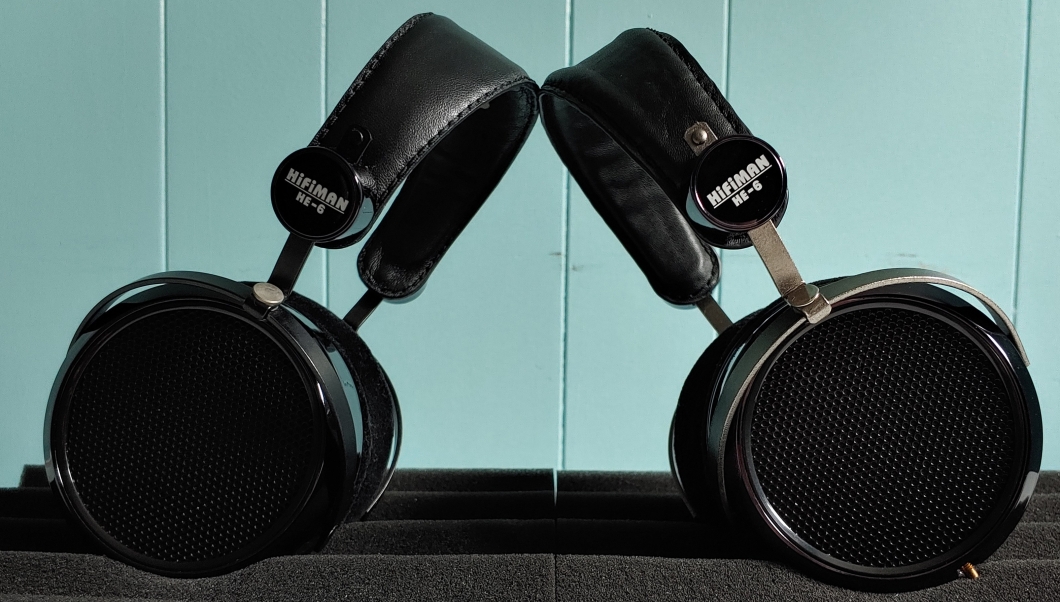
The HE-6 uses the classic housing shared with many models, the most recent one being the HE-4XX. The 4S and 6S differ externally, with the earlier models sporting a darker take on the glossy dim purple finish.
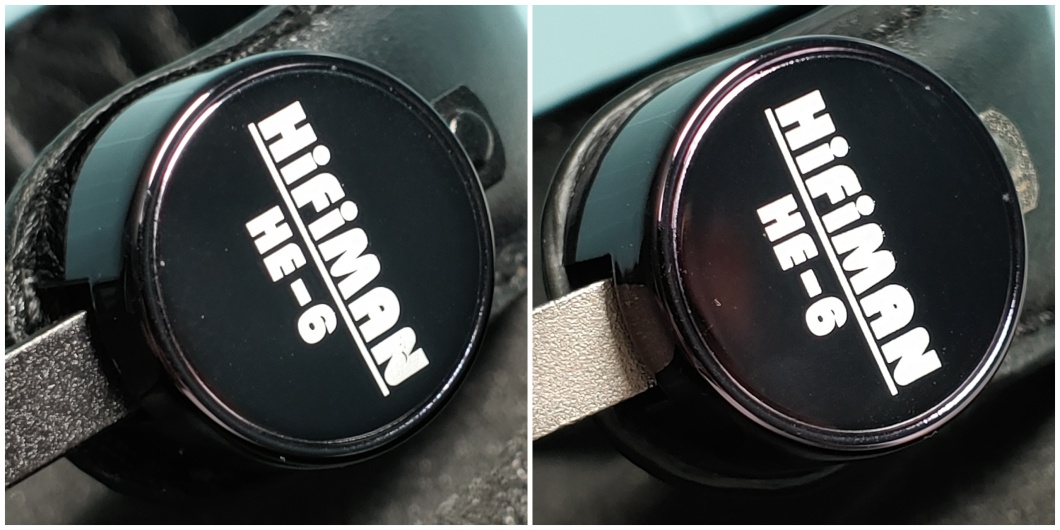
Earlier models also rocked either smooth silver or black yokes, versus the 6S’ gritty/rough silver yokes.
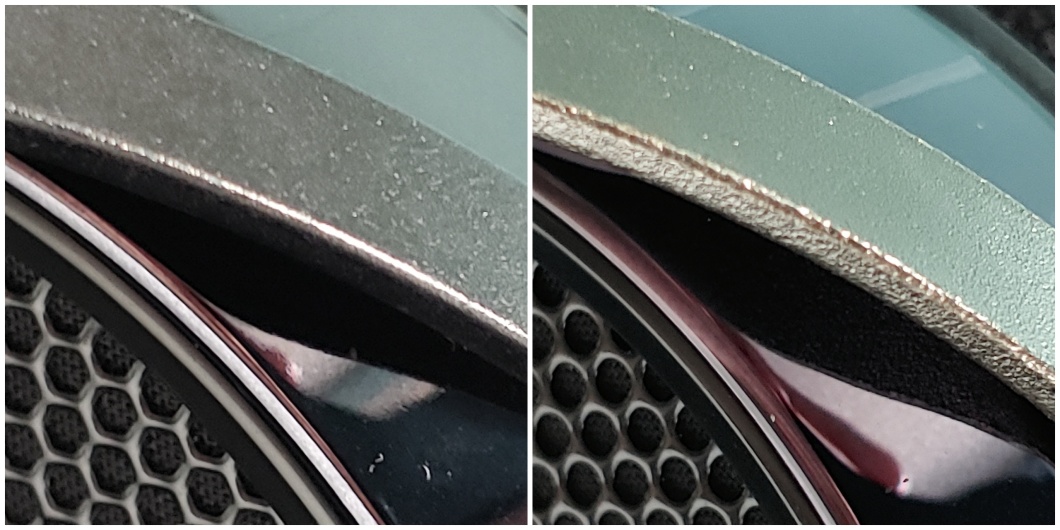
Neither headphone is particularly well-built as expected for early HFM, but the 4S is machined in a clumsier manner. The internal edge of the ear cups exhibits a “ridge” that is smoothed over on the 6S, which also use larger, sturdier screws at the level of the yokes and a tighter ear pad mounting system (making it harder to rotate ear pads).
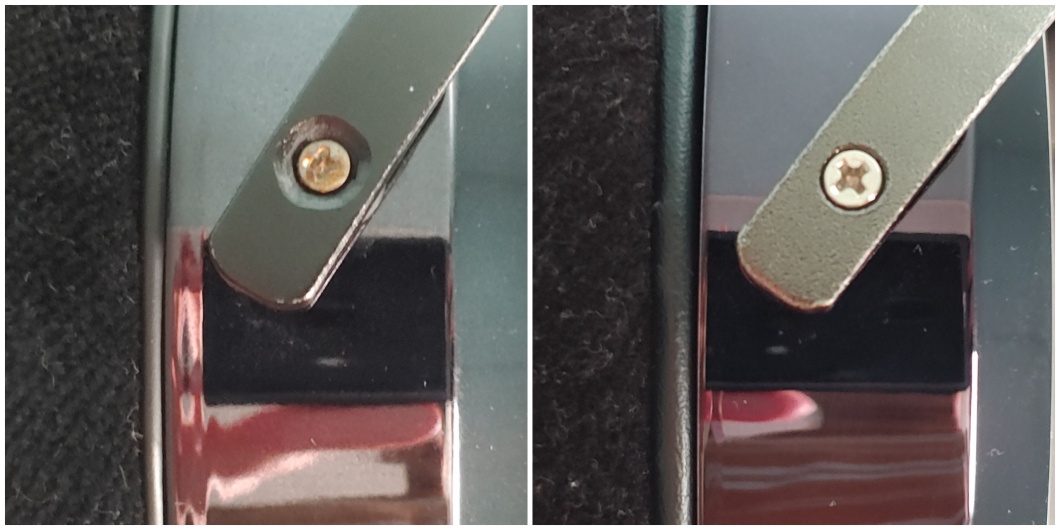
Peering inside, you may see a bit more glue around the edges of some (not all) 6S drivers. Looking at the golden protective diaphragm mesh, the 4S models’ is wound tighter. One possibly important distinction that may allow one to differentiate between possible 4S revisions is the color of the screws and of the area surrounding the baffle. The 4S-EP sports shiny silver screws and a dark purple (body color) baffle surround, whereas the 4S-LP has black/dark grey screws and a silver/chrome outer surround.

On the outer end of the driver, revealed by removing the grill and rear damping foam and cotton, you can see that both 4 and 6 screw use some SPC or silver internal wiring to connect the drivers to the SMC female jack.

Both the 4 and 6S models come with pleather and velour ear pads, which also differ. The 6S pleathers come with a removable closed cell foam spacer that increases the depth of the pads, absent in the 4S pleathers. Interestingly enough, the 4S velours sack the traditional removable plastic ring mounting mechanism used in the 6S for a seemingly jerry-rigged clear plastic coupling mechanism that is glued to the pad, extremely fragile and difficult to install. The earlier velour pads themselves are stiffer, with a slightly wider ear opening and a brighter sound (measured later).

Both headphones use a 4-core OCC 2m cable that likes to corrode over time, terminated in 4-pin Yongsheng XLR plugs (black on 4S and silver on 6S), along with a 1m ¼ inch adapter. It is worth noting that depending on production, the SMC pins either come tagged with red or blue circles (4S-EP), or lettered L/R indicators (4S-LP and 6S).
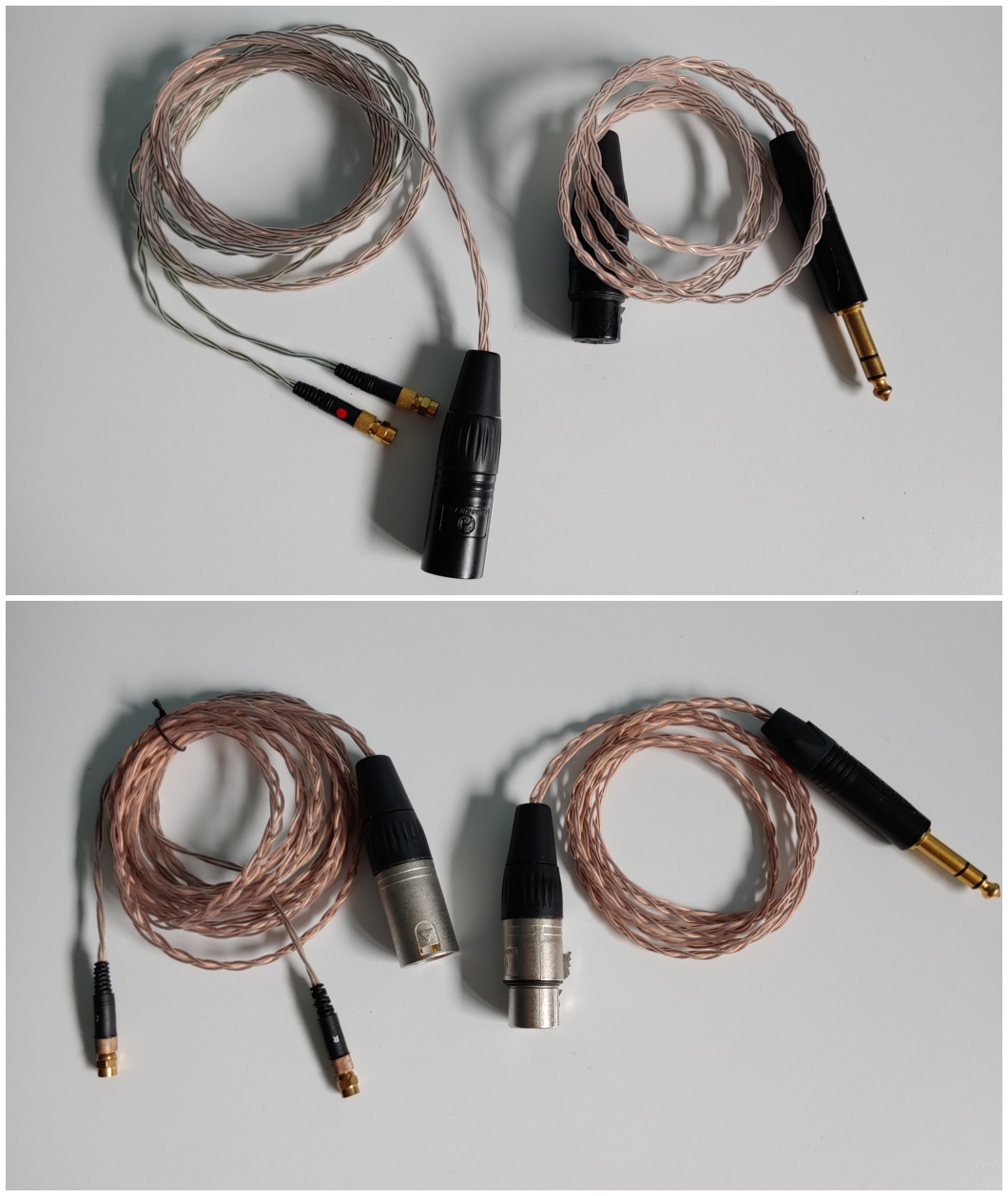
Here is a table summarizing the observable differences between different HE-6 production batches. NOTE: There may be some overlap here. For example, a few 4S-LP units came with gritty silver yokes and silver XLR plugs found on the 6S.

NOTE: You may be wondering what my rationale is behind the distinction between “early” and “late” 4 screw, so here it is (once again, feel free to skip):
- Silver baffle screws: the HE-5 (HFM’s first planar from 2009) and HE-6 prototype are known to use silver baffle screws.
- Colored L/R cable indicators: the HE-5 and HE-6 prototype both use colored L/R circles on the SMC cable pins, as opposed to the later 4 Screw and 6 Screw, which use lettered L/R indicators.
- Smooth silver yoke on similarly sensitive example: Before this comparison, I’ve owned a very early 4S, which had the smooth silver yokes featured on the HE-5, HE-6 prototype and very first HE-6 marketing photos used by HiFiMAN. Its sound characteristics and sensitivity spec were similar to the black-yoked “4S-EP” I am reviewing here (roughly 1 dB more sensitive than the 6S), so it is reasonable to assume that it wasn’t produced too far apart.
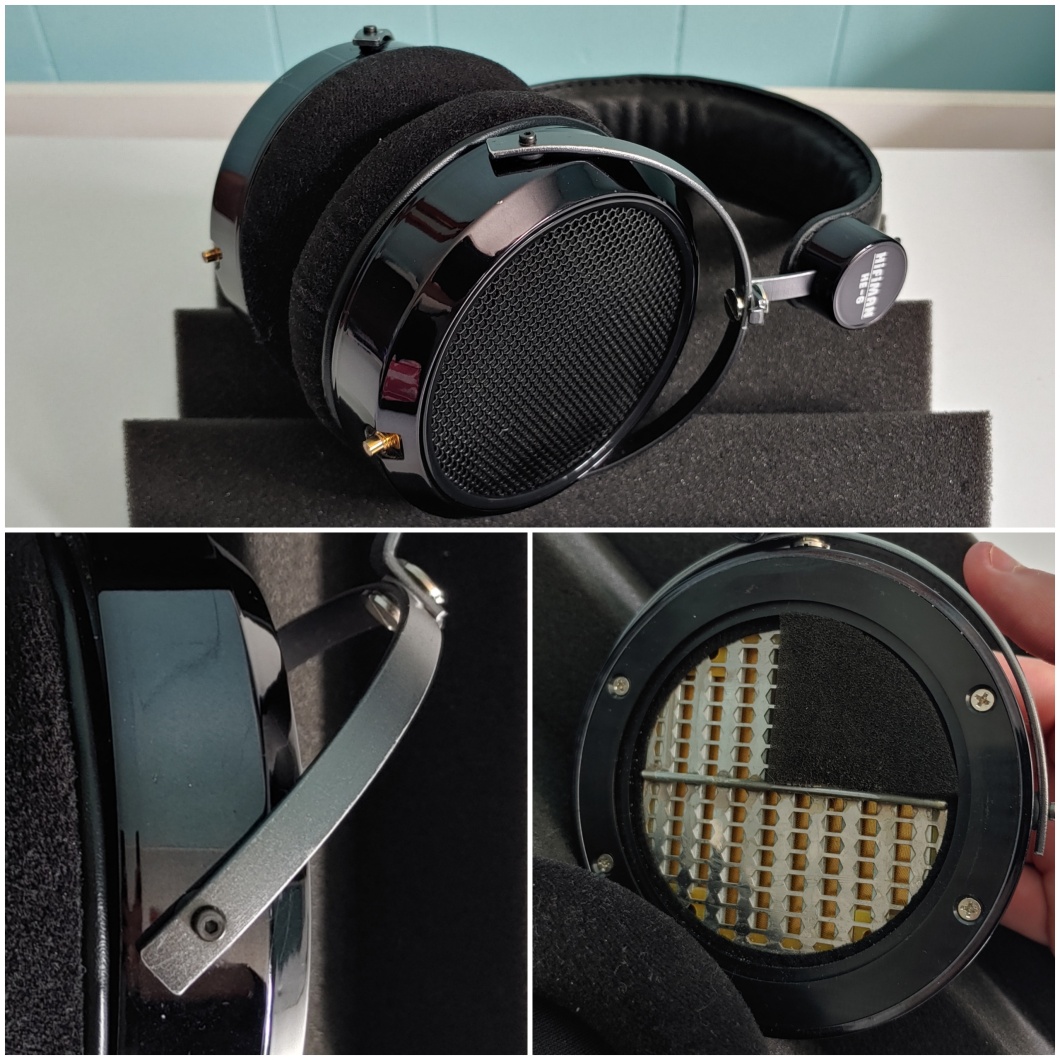
I’m unaware of the exact production dates, so that could very well be wrong. Also, even though many of the differences strike me as actual revision changes, the possibility of variance still exists – so, as always, take with a grain of salt.
Comfort
The HE-6 is a moderately comfortable headphone (YMMV). Weight (~500 g) and clamping force are somewhat higher than others but not problematic in my experience. Ear cups articulate in the coronal and transverse planes, ensuring proper seal, and the headband adjustments have a fair amount of travel, fitting a variety of head sizes. The stock ear pads are acceptable in terms of comfort but may feel firm, though they are easy to swap (anticipate sonic changes). My biggest comfort qualm would be pressure spots on the center the head, likely due to sub-optimal headband padding and/or curvature, but I imagine this being mitigated by third-party solutions like ZMF Pilot Pads or the Lohb strap.

Durability & Failure Points

When purchasing an HE-6, it is reasonable to expect a higher likelihood of failures than in other headphones for two main reasons, the first being is the yoke. The plastic badge cover can fall off, or worse, the entire assembly can come unglued from the spring steel, leather-covered headband. Thankfully, it’s possible to swap to modern HFM assemblies or, better yet, Audeze headbands, but those are some invasive and somewhat advanced mods that require drilling or dremeling.
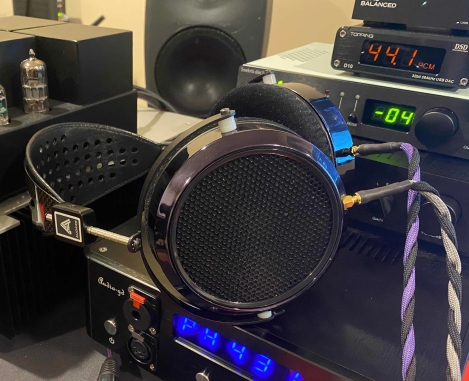
While cables are also known to corrode and break, a much more painful failure point exists: the driver. Multiple users have reported transducers breaking over the years, but the reasons still aren’t clear. One plausible reason is poor volume control with the popular use of high-powered speaker amps with these, but no absolute answer exists as to their nature. HiFiMAN now quotes $350 (up from $200 in 2018) for repairs, but there is no word on whether one or both drivers are replaced, matching, and whether they are original HE-6 or HE-6se drivers.
Sensitivity & Amplification
The HE-6 is an extremely insensitive headphone, but there seem to be differences among the units I have used. Here are a few readings at 300 Hz on my MiniDSP EARS for the same voltage input, with the same ear pads, on the three pairs I am reviewing:
- 4S-EP: 90.0 dB
- 4S-LP: 84.7 dB
- 6S: 89.1 dB
Nevertheless, all seven pairs I’ve listened to were extremely power hungry. While many headphone amps will provide you with adequate volume, a high quality, high current source will benefit performance. In fact, the HE-6 is so insensitive that it sparked a trend of people using speaker amplifiers as last gasp attempts to drive it. This can sometimes work very well: certain ones I’ve tried (e.g. a modded McIntosh MC225) straight from the taps resulted in improved bass slam and reduced treble grain. However, it’s not a simple matter of “more power is better” – quality matters too. For example, from a 40WPC class D Dayton DTA-120BT2, impact was lacking, top end was harsh and detail was heavily masked even when compared to my much less powerful iFi Micro iDSD Black Label.
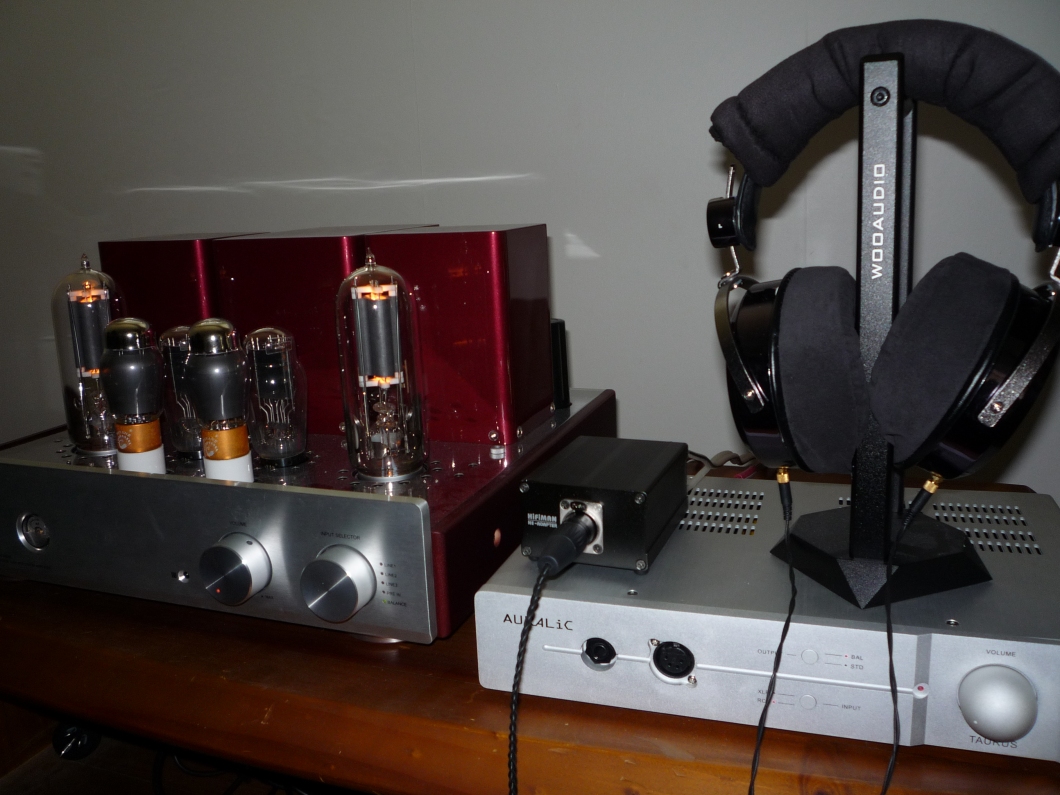
For safety reasons, if you’re going to use a speaker amplifier, be careful with the volume knob as you may end up overpowering the headphones. It’s also crucial to never leave the headphones plugged in when powering on and off to prevent DC voltage spikes, which can blow drivers out. The HE-Adapter (an attenuating resistor box and banana to XLR adapter) may serve as an additional layer of protection with speaker amps, but on certain tube models, it may be necessary to avoid impedance mismatch.
Sound
I will be assessing the sound between what I believe could (not certainly) be three “driver revisions” among the seven pairs I have listened to:
- Early 4 screw (4S-EP): I’ve had two of these (silver screws + body-colored surround), one silver yoke and one black yoke, both of which sounded similar and exhibited similar sensitivity.
- Late 4 screw (4S-LP): I’ve had one of these (black/dark grey screws + chrome-colored surround). It sounded different from the earlier 4 screws, and was much less sensitive (~6 dB).
- 6 screw (6S): I’ve owned three of these and have listened to a fourth pair. They all sounded similar to one another with similar sensitivity.
Assessment was made with extended listening of each pair and extensive A/B/C/D testing, using the same late production (i.e. 6 screw) velour ear pads on each one. A/B/C/D testing was done volume matched at 300 Hz on my MiniDSP EARS due to the varying sensitivities. I’ve also had a good friend of mine, dleblanc343 from Head-Fi, participate in some of the testing, during which we discussed our impressions. Cheers, Dan!
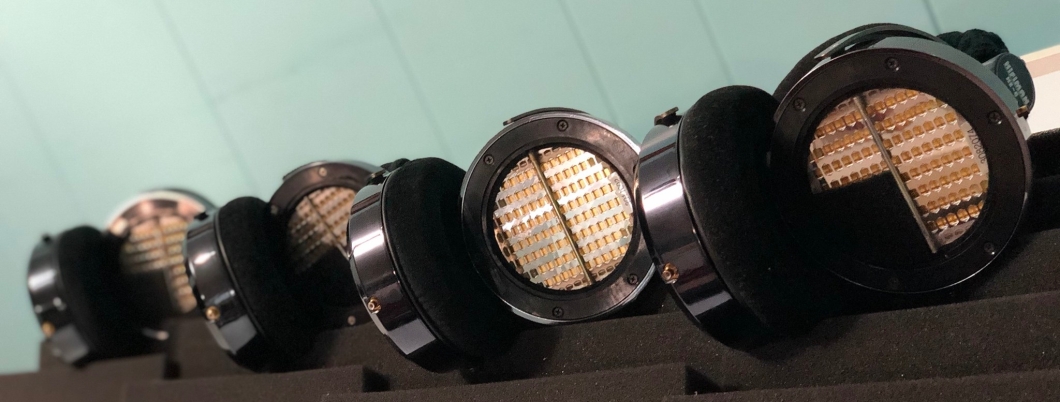
So: how do these things sound?
Let’s get one thing out of the way first: these are all HiFiMAN HE-6, and they all share the same overall character. A very lively and dynamic presentation with well-extended and punchy bass, slightly recessed upper midrange and a significant lower and mid-treble boost. However, despite their common pedigree, some notable differences exist.
Bass
Common Character
Bass is one of the HE-6’s strongest suits. It is tuned to a neutral level relative to overall FR, with near-bottomless extension. The lowest registers convey a superbly authoritative sense of sub-bass rumble, with a sense of heft and mid-bass impact that is some of the most gripping I have heard in any headphone. In fact, it can almost falsely sound boosted simply due to its exceptional macrodynamics. Underwhelming slam is one of the typical downfalls of planars when compared to dynamic drivers (despite their better extension), yet this hits harder than any dynamic I’ve heard except for the Fostex TH900 and Focal Utopia. Not only is the low end punchy, but also controlled – it doesn’t come off as wooly, artificially thumpy, bloated or “one-notey”. Low end may not have the speed of many other planars I’ve heard (e.g. HiFiMAN Susvara, Audeze LCD line), but its more sustained decay is an element of satisfaction. Without a doubt, this some of the finest bass I have heard out of any headphone.
Differences
What was said above applies to all three, but the 6S is the punchiest and “dirtiest”, with more weight, body and slightly more extended decay than the others. The 4S-LP trades away some impact for a tighter and faster delivery that is more refined, but a touch anemic in comparison to the 6S. Make no mistake, however, this is still far more satisfying than in most other headphones. The 4S-EP seems to be right between both when it comes to both slam and speed, albeit a bit closer to the 6S in those regards.

Midrange
Common Character
The midrange on the HE-6 is odd. It’s tuned slightly warm, with a typical HiFiMAN-esque recession around 2 kHz that somewhat suppresses upper harmonics, preceded by a small 1 kHz bump. You may expect a warm midrange to come off as thick, but the discontinued planar comes off as texturally dry and plasticky, which disturbs timbre. Dynamic contrast is, once again, stellar. Attack is clean and sharp (unlike in the larger-diaphragmed HFM planars, which are blunted) and the headphone showcases good speed, but, as with most other planars, decay does come off as unnaturally brisk, especially on certain stringed instruments. Detail retrieval is exemplary within the price bracket, but midrange resolution does leave some to be desired: it’s somewhat hazy when stacked up against competitors like the Sennheiser HD 800 and Focal Clear. Another issue I’ve encountered in the HE-6 is some odd grain in the upper midrange that’s most obvious on vocals – upper harmonics sound rather etched and gritty, almost “glary” despite their tonal recession. Globally, despite the quirks, the midrange is good. There’s nothing genuinely offensive about it (e.g. 3 kHz canyon of Elear/Elegia), but beyond the vivid dynamic contrast and respectable detail, it fails to impress.
Differences
Once again, the assessment above applies to all three varieties, but some small discrepancies still exist. The 6S exhibits a bit more sustain in the lower midrange decay which imparts some warmth and well-needed bloom in comparison to the other models. This slightly improves on the thin and “unnatural” aspects of the timbre, but it’s also the haziest of the cohort by a discernible margin. The 4S-LP is the fastest by a bit, with the least upper midrange grain, but it’s also the leanest texturally and the most dynamically compressed (approaching the presentation of large-diaphragmed HFMs). It also strikes me as most resolving and least hazy. The 4S-EP sits, once again, in the middle of this tug of war of texture vs. resolution, but this time closer to the 4S-LP.

Treble
Common Character
Treble is, in my opinion, the HiFiMAN HE-6’s Achille’s Heel. It’s tuned north of neutral, due to a significant and fairly wide bump in the lower to mid-treble. Texture is on the grainy and metallic side – a far cry from the likes of the HiFiMAN Susvara and STAX SR-404, which display much cleaner, “ethereal” treble qualities. Contrary to egg-shaped HFM models (HE-1000 v1/v2, Arya), upper treble extension is quite good: the HE-6 is able convey a convincing sense of air and sparkle, but it may get clouded by the low-mid treble boost. Macrodynamics remain, just like in the rest of the FR, exceptional here – an exciting sense of “crunch” and “bite” is delivered within cymbal crashes and snares, but due to the somewhat hazy and etched timbre up top, the presentation may come off as sharp and rather fatiguing.
Differences
This where discrepancies are most obvious between the three units. Immediately, both 4 screws deliver more energy in the upper treble, sounding more airy, sparkly and a tad less congested as a result. Top end resolution isn’t the HE-6’s forte, but the 6S decidedly sounds grainiest and most etched in this area. This, in conjunction with its extra dynamic “bite”, makes it sound most fatiguing even though it isn’t brightest in terms of FR. The 4S-EP is a slight improvement in resolution, but it gets overshadowed in this area by the less sensitive 4S-LP, whose treble is the least textured, but cleanest and least sharp. Oddly enough, it also seems to have the least energy in the lower treble, which may be contributing to its less metallic tone.

Intangibles
The HE-6 projects a somewhat intimate and narrow soundstage, with slightly subpar image depth, making it sound more or less “two-dimensional” despite the decent soundstage height, which is still nowhere close to the likes of HE-1000 and Arya. The late 4S sounds a bit wider than the other two at the slight expense of center image. Overall detail retrieval is very good on all three models, but as mentioned previously, treble resolution is somewhat lacking (with the 6S being most affected). The HE-6 is a fast headphone, especially in the midrange (which comes at the expense of timbre), with the late 4S being most nimble but least textured. Finally, dynamic contrast, especially macrodynamic, is stellar from top to bottom on all three models, but the 6S carries a slight edge over its predecessors. In all aspects, the 4S-EP sits between the 6S and 4S-LP, so it may be relevant to view this comparison as a spectrum.
- 6S: Most dynamic and textured, warmer/darker, grainiest and least resolving.
- 4S-LP: Most compressed and ethereal, leaner/brighter, least grainy and most resolving.
- 4S-EP: In the middle.

Once again, I would like to stress the point that all three of those headphones sound like the HiFiMAN HE-6. The differences exist, but they aren’t extreme: the overall character remains the same. You may have also noticed that both 4S and 6S have their own strengths and weaknesses, so depending in your priorities, your preferences may lean towards one or the other: one isn’t “objectively” better than the other. Speaking of objective…
Measurements

Here are the FR measurements of all three units. They were taken using the same pair of 6 screw velour ear pads, matched at 90 dBSPL @ 300 Hz, with HPN compensation on my MiniDSP EARS.
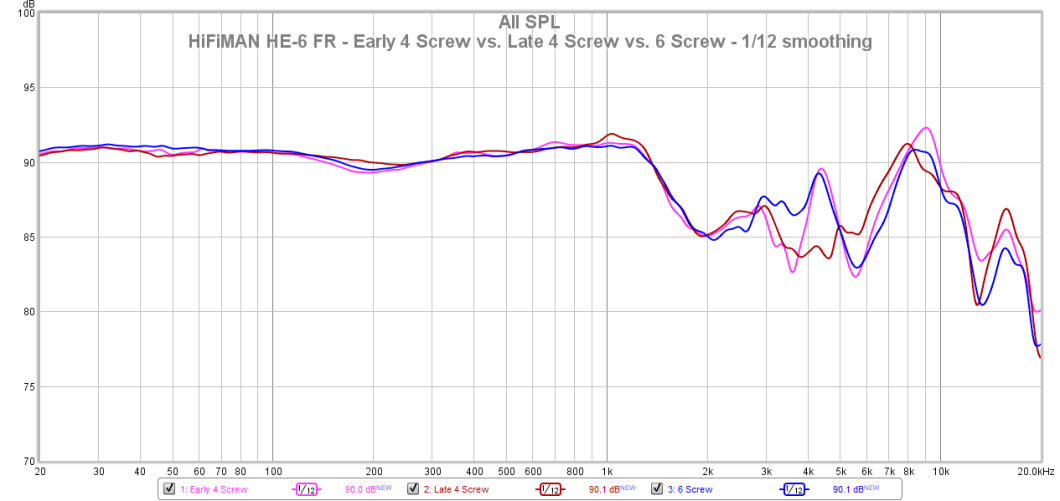
The three headphones vary very little from 20 to 2000 Hz, with a flat curve that slopes down into the typical HiFiMAN 2 kHz scoop, following into a mid-treble peak constituting the subjectively perceived warm-bright tonality.
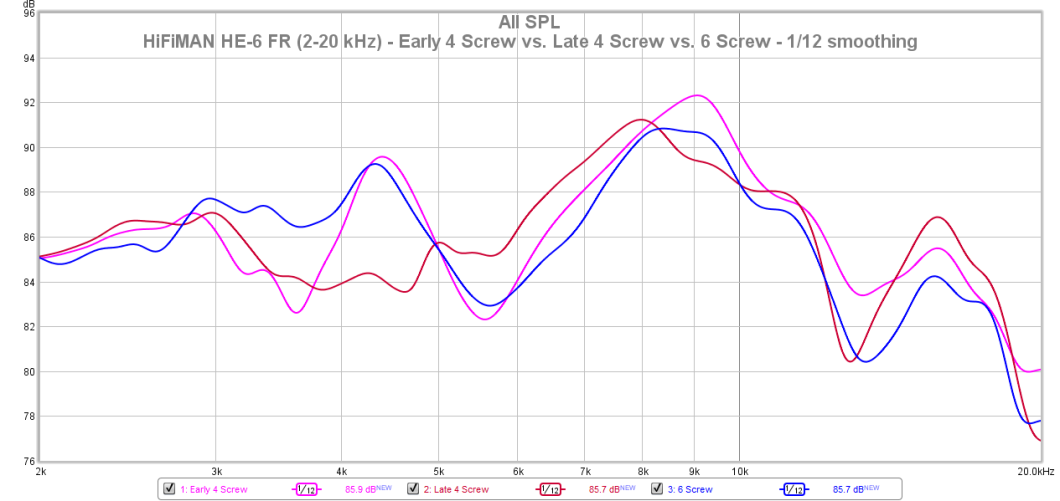
Looking more closely from 2 to 20 kHz, differences become more obvious. In the lower treble, the 4S-LP seems to have the least energy, whilst both the 4S-EP and 6S showcase a peak around 4.5 kHz (likely the infamous MiniDSP EARS resonance). However, it’s interesting to see that this feature is absent from the 4S-LP FR. All three also show a substantial peak centered around 8-9 kHz, with the 4S-LP looking best behaved in the area (though, to my ear, the peak would be located more around 5-7 kHz – possibly another inaccuracy from the EARS). Finally, whilst EARS graphs are extremely unreliable in the upper treble, the 6S appears most rolled off, which is consistent with what I am hearing.

Looking at the non-smoothed graphs, the 4S-LP seems to showcase a very narrow dip-spike around 4.7-4.8 kHz on both channels, which was also audible on sine sweep. This is characteristic of an “ortho wall”, which is a resonance that should be picked up on CSD. However, interestingly enough, I personally found this unit to be the cleanest sounding in the treble.
Modifications
Many HE-6 owners enjoy tinkering with the sound through a variety of modifications. These can be very extensive, as shown by a few examples from other community members.


Thankfully, you don’t need to go crazy to tweak the sound. Some simple and reversible modifications will result in significant changes.
Pad swapping
One valuable asset of the round HFM headphones is their compatibility with most full-size earpads, thanks to a removable mounting ring. The HE-6 is somewhat reactive to pad swaps, so you may use this technique to “tune” it to your liking – not only the tonality, but certain intangible qualities such as bass slam and imaging.

Whilst I am not a fan of generalizations, I felt like pure leather/pleather ear pads weren’t the best match on the HE-6 – they usually generated a significant sense of haze in the midrange with only minor gains in slam. I found more permeable velour/suede ear pads more to my liking, as they sounded somewhat less congested. However, this statement may not apply to all ear pads – there are many I have yet to hear. If you own an HE-6, or any round HiFiMAN for that matter, I encourage you to experiment with different combinations.
My favorite ear pads were the stock 6S velours used for the review, but here are a few examples of others compared to them on the early 4S (4S-EP).


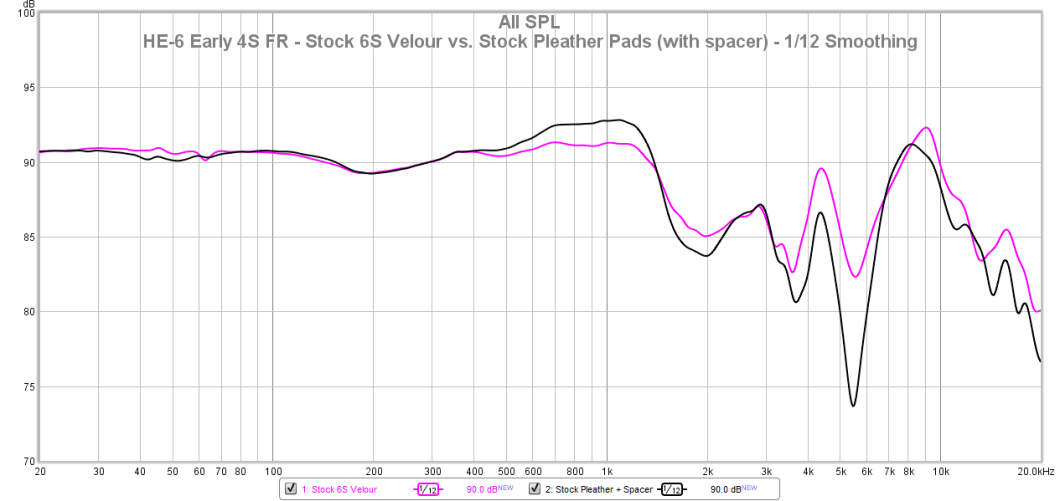
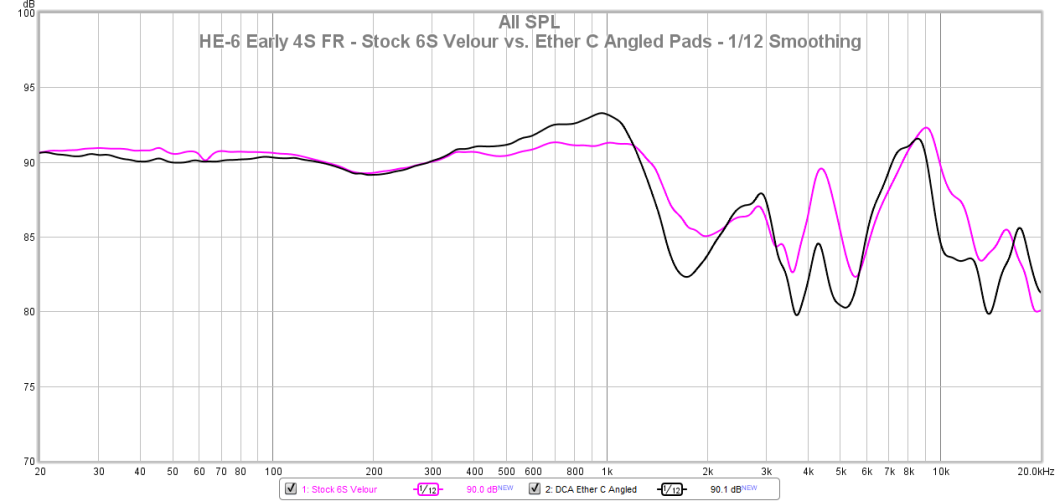
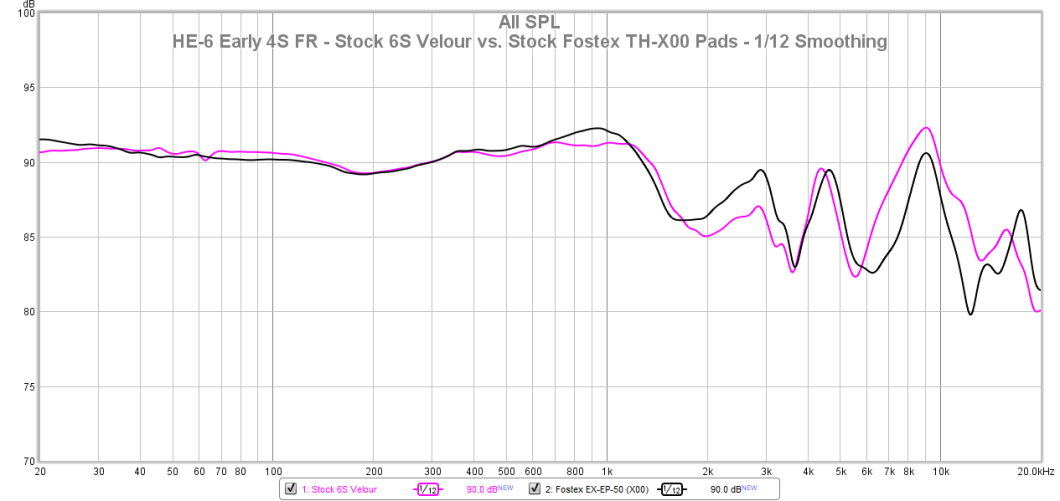

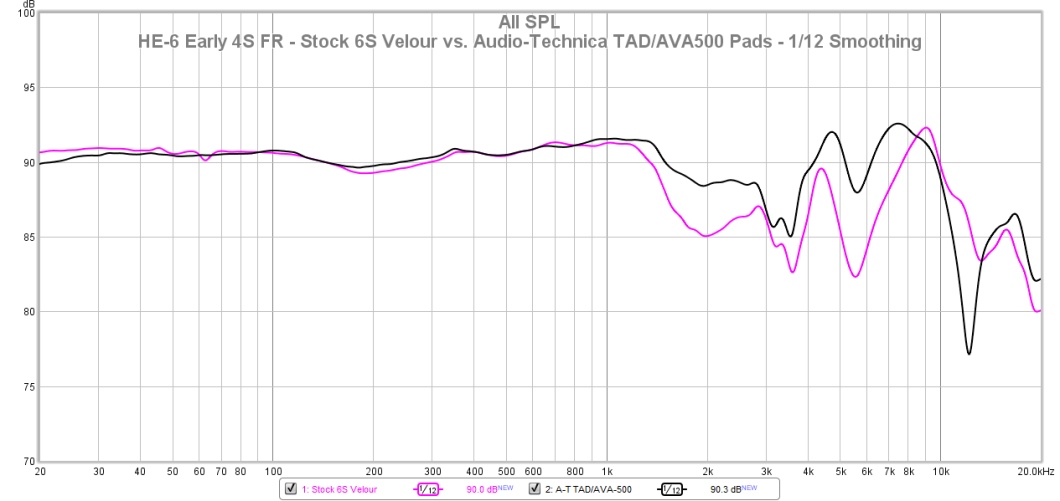
“Grill Mod”

This consists of removing the rear foam and cotton damping and the rear grill (sometimes in favor of a less permeable grill), reducing the acoustic impedance on the rear, which affects sound. Here are measurements showing the individual effects of removing either the grill or damping, or both on the late 4S (4S-LP).

Removing the stock grill (and leaving the damping inside) generates a small boost in the bass and midrange (~1 dB) and slightly reduces the energy from 10 to 12 kHz (this may not be entirely accurate due to the nature of the EARS).

Removing the rear damping (and leaving the grill in place) has a more significant effect, generating a slightly larger bass and midrange boost, albeit without the treble reduction seen in grill removal.
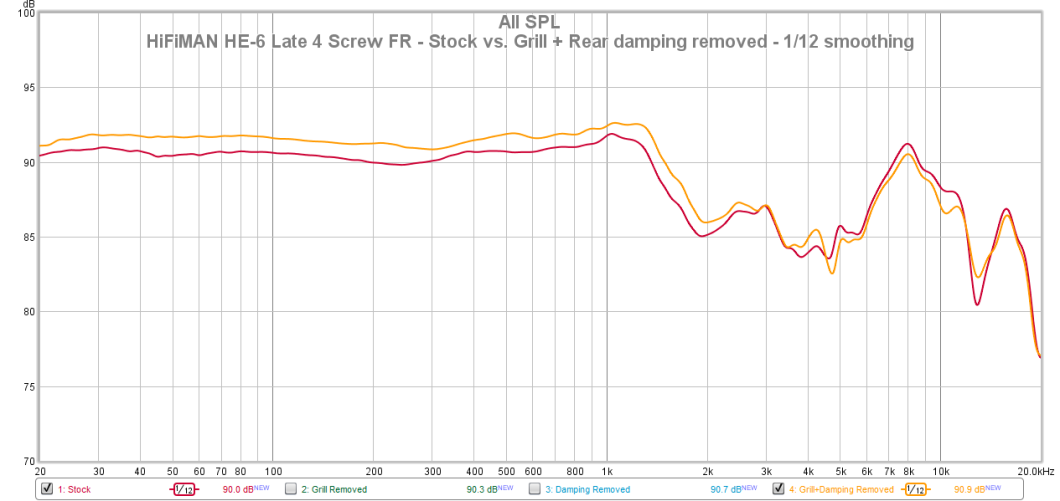
Removing both the grill and rear damping demonstrates the complementary nature of the mods: the bass and midrange boost is largest, on top of a slight reduction in treble energy.
The subjectively perceived effect of the mods is a darkening of the sound due to the increased energy in lower frequencies, and a notable improvement in the treble “etch” that the HE-6 exhibits. I enjoyed the change and would recommend the modification to HE-6 owners who are bothered by harshness. However, full grill removal exposes the somewhat fragile driver to dust and particles, and if you’re unlucky, the magnets may attract pieces of metal nearby due to their high flux density. As such, I would recommend only removing the damping, as it gets you most of the benefits of a full “grill-less” mod, yet maintains the grill’s protection for the driver.
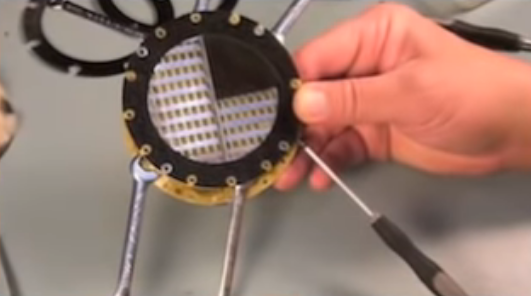
Verdict
If you’ve stuck around until the end, or have simply skipped here, here are the conclusions of this write-up:
- The HiFiMAN HE-6 is known for its main revisions: 4 and 6 screw. However, there may have been two versions of the 4 screw model.
- The newer HE-6se driver is designed differently from the original HE-6.
- Multiple external differences allow you to determine whether an HE-6 is early 4 screw (4S-EP), late 4 screw (4S-LP) or 6 screw (6S).
- Whilst the HE-6 enjoys power, different units will vary in sensitivity, possibly due to driver revisions (or variance).
- The overall character of the HE-6 is tonally warm-bright, with top-tier dynamic contrast and slam being its most notable quality. Its worst downfall is the somewhat etched and grainy treble.
- The early/late 4 screw and 6 screw all share this character, but with small (not night/day) differences in the “intangibles”: dynamics, speed, timbre, resolution and imaging.
- The 6S is warmest/darkest by a touch, with the best macrodynamics, texture and timbre, but worst resolution and grainiest treble. The 4S-LP is more airy, slightly wider, most resolving and least grainy, but also most compressed and ethereal. The 4S-EP sounds like an inbetween of both. The three can be seen as forming a spectrum.
- Owners can tweak the sound to their liking with simple, reversible mods – pad swapping and grill/damping removal. More extensive modifications also exist.
While HiFiMAN’s recent efforts in planar magnetic technology are admirable, they beg the question: has the pioneering Chinese manufacturer been straying away from its roots? Sure, newer models, apart from the one-off throwback HE-5se and HE-6se, are an overall “technical” step up. However, it seems that along the years, some of the spirit has been lost across their range of products. For example, when comparing an HE-400 to an HE-400i or Deva, an HE-500 to a Sundara or an HE-6 to an HE-1000 or Susvara, you may notice the direction HiFiMAN has been taking with their modern headphones: fundamental qualities of texture and raw attack have been somewhat abandoned in the pursuit of speed and resolution. While satisfaction lies on both sides of the coin, I wish to see the constructor craft another sound that captures the soul of their earlier endeavors – a soul that the HE-6 still epitomizes as the years flow on.

My HE6 has 6-screws but..
the headband looks like a 4 screw headband with 4screw headband screw holes. the driver is missing serial number, the foam trinagle looks like it looks on the 4late production photos you have, and the included cable was all black. I think i might have a frankenstein of somesort. I have a macrolens so I could send you some picks if you can help me identify what i actually have 🙂
LikeLike
Hi David,
Of course, feel free to send some pictures!
LikeLiked by 1 person
Let me know if you need to see something else. Pictures are in the link
https://1drv.ms/u/s!AiTQgspGNYdgh9lOHVydzX3lfyalLw?e=Sx7Wpj
LikeLike
Hey there! Here’s what I think.
– Body: purple color is characteristic of a 6 screw frame.
– Baffle surround: black screws, chrome surround – much like the late 4 screw! Though as mentioned in the article I have seen 6 screws with either chrome or body colored surround, and have never really attempted to “date” them to a specific production era. So again, I think that’s from factory.
– Driver: definitely 6 screw, not only because of the screws, but also the mesh and edge glue quantity.
– Yoke: now I must say this part is throwing me off a bit! The gritty texture is characteristic of 6 screw, but I’m unsure about the color. Can you please take a photo of the yoke under brighter lighting, and also a photo of the screw that attaches to the cup?
So far, to me this looks like a 6 screw! Possibly early 6s, due to the chrome surround which was shared with late 4, but I cannot say that confidently.
LikeLike